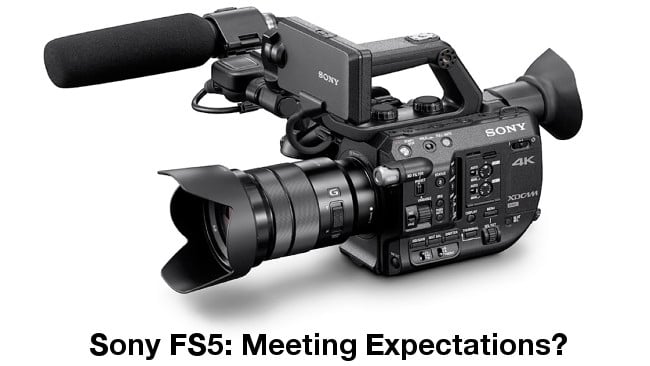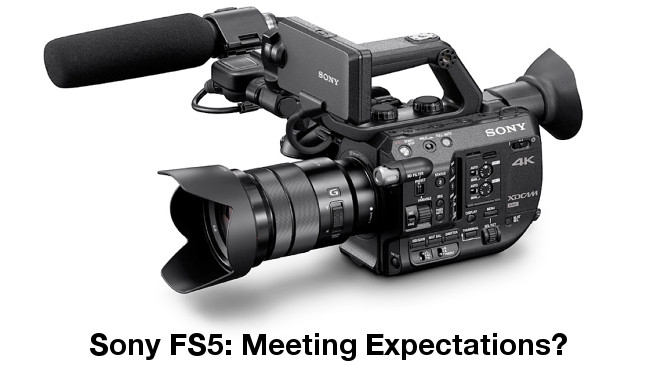
 Sony FS5
Sony FS5
We consider the uproar over the lack of a low compression 4K codec for internal capture for the Sony FS5 and why it speaks more to our outsized expectations than it does to any perceived limitations.
If Dire Straits had composed one of its seminal hits today, it could be called Something For Nothing. Such has the electronics world developed that we are now routinely using devices that, up until only a few years ago, would have only been seen in science fiction movies. Has this speed of development meant that we now expect the world for virtually nothing?
Expanding field
Where video cameras are concerned, we really have taken momentous shifts in various paradigms, from overall design and usage, through to price. Remember the mid-2000's? If you wanted a professional camera you could rely on, you could pick from Sony, Panasonic and JVC. If you were a studio, then Hitachi and Grass Valley were also options, but on the whole we relied on the first three manufacturers. The idea of a start up making its own video camera was absolutely preposterous…until Red came along and threw great big cartoon sized spanner into the works.
These days, we aren't surprised when a new company comes along into the marketplace and we look at new projects with interest rather than suspicion. The problem is that, with companies such as Blackmagic offering inexpensive devices with the holy grail of recording (DNG raw) as well as all flavours of Prores, this can make us rather over critical of systems that do not fit our new imagined paradigm of how things should be.
Unrealistic expectations?
A case in point is the new Sony FS5. From cursory standpoint, one would assume that it is merely a cut down FS7. Our new world view says that this should be the case. Only it isn't. But the fact that the model designation and the base chip inside the camera is related to the FS7 means that some quarters are expecting an FS7 in mini form. When the recording codec doesn't perform as well as X, Y or Z camera, then umbrage is taken.
The recent furore over compression artefacts in the FS5 recording system shows that perhaps the video production community is expecting too much. The FS5 is not a miniaturised FS7 and it was never intended thus. It has specialist uses that can compliment the FS7 and it can be used by those on a budget, too. But it is not an all-out cinema camera. It was designed to be very light and portable, as well as to give you maximum bang for your buck when it comes to storage requirements, while allowing you to still compose those lovely shallow depth of field shots you always craved.
Value beyond a codec
The retort to this is that Blackmagic makes cameras that record Prores and raw for much less. Now, as much as I absolutely love the Blackmagic cameras, let's take a short look at what you get for when you pay for the FS5. Forgetting the issues some have with the 4K codec, you get 50Mbps recording in 1080 resolutions at up to 60fps, as well as some ultra low bitrate recording modes that may be of use to journalists. You get an awesome linear variable ND filter (the Blackmagic cameras have no ND filter, which cuts down the practicality by a large degree in some cases). You get S Log 3 gamma. You can record 120fps at usable resolutions, up to 800fps if you are prepared for the quality hit. You get SDI output, fairly decent audio circuits with a full size XLR input and you gain the ability to use batteries such as the ubiquitous BP-U90, which will give you nearly 7hrs recording time on a single charge!
In other words, no, the codec might not be all you 'want' it to be, but the camera was never designed for high quality cinema work. You can always attach an external recorder, if that is what you want. But, in the main, you are getting a lot of other features that are not on lower priced competitors, such as the amazing variable ND filter, the modular construction, the ultra long battery life and the networking capability (it is mainly a journalist and documentary makers tool, after all). And, no, the optical variable NDs on the market are not suitable alternatives to the one built into the FS5.
To put things into perspective, the codec on your camera is only part of the equation. Before criticising such things, take into account what the camera was really designed to do, as opposed to what you feel it should have been created to do. For those who still see the lack of a low compression codec in 4K for the camera as an issue, there's always companies called Atomos, Convergent Design and even Blackmagic who offer bolt on solutions – an aspect of production you will be (or are already) used to, as external recorders are a common workflow addition when operating many other makes of camera.
Tags: Production


Comments